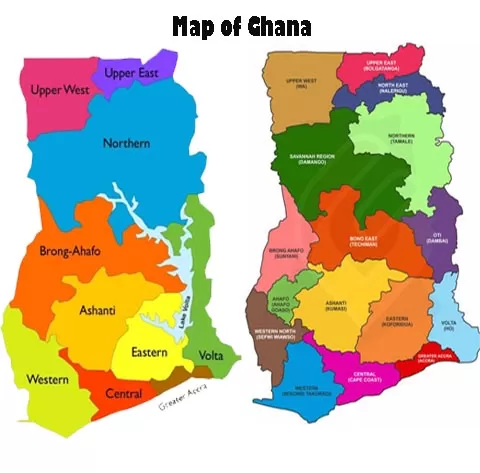Being the center of the world and specifically West Africa, regions in Ghana consisted of a total of ten (10) till recently 2020, they were divided into sixteen (16). The regions are further divided for administrative purposes into 260 local metropolitan, municipal and district assemblies (or MMDA’s).
There former ten (10) regions included Ghana is divided into ten regions as the highest administrative division. These regions are Ashanti, Brong-Ahafo, Central, Eastern, Greater Accra, Northern, Upper East, Volta, Western and Upper West.
The former ten regional boundaries were officially established in 1987, when the Upper West Region was inaugurated as the state’s newest administrative region. Although the official inauguration was in 1987, the Upper West Region had already functioned as an administrative unit since the break-up of the Upper Region in December 1982, prior to the 1984 national census. The referendum on the creation of six new regions was held on 27 December 2018 – all proposed new regions were approved.
At Independence in March 1957, the Northern Territories, Trans-Volta Togoland and the Gold Coast came together to form Ghana. There were initially five regions. The Trans-Volta Togoland was combined with part of the Eastern Region and Northern Territories to form the Volta Region.
On 4 April 1959, the Ashanti Region was officially split into the Ashanti and Brong-Ahafo Regions. This followed the Brong Ahafo Region Act No. 18 of 1959. This was in line with what the Brong Kyempem movement had been campaigning for, which is the recognition of the Bono people as a separate ethnic group from the Ashantis with their own region.
On the day Ghana became a republic, 1 July 1960, the Northern Region got split into the Northern and Upper regions raising the number of regions to seven.
During the second republic, the Western Region was split into the Western and Central Regions, making eight regions in total. This was done ahead of the 1970 population census. In 1971, Sekondi and Takoradi were merged to form Sekondi-Takoradi, the new capital of the Western Region.
The Provisional National Defence Council which was the military government in power between 31 December 1981 and January 1993 promulgated the Greater Accra Law (PNDCL 26) of 23 July 1982 which created the Greater Accra Region.
This made the Accra Capital District, where the national capital, Accra was and the Ada Local Council, both areas within the Eastern Region parts of the new Greater Accra Region. In the following year 1983, the Upper Region was divided into the Upper East Region and Upper West Regions, bringing the total number of regions to ten.
What are the 16 regions in Ghana?
Following a referendum that was held to further create regions out of the ten, another six (6) were created making the current the regions in Ghana sixteen. In the referendum, new regions were accepted with a high vote rate of 80%.
According to the new structure, new regions will be created with the names of Western North, Oti, Ahafo, Bono East, Savannah, and North East and the number of regions will be increased to sixteen. The implementation of this new outcome of the regional creation took effect in 2020 when the current 16 regions were created.
| New 16 Regions | Regional Capitals |
| Ashanti | Kumasi |
| Greater Accra | Accra |
| Bono | Sunyani |
| Bono East | Techiman |
| Central | Cape Coast |
| Ahafo | Goaso |
| Eastern | Koforidua |
| Northern | Tamale |
| Savannah | Damongo |
| North East | Nalerigu |
| Upper East | Bolgatanga |
| Upper West | Wa |
| Volta | Ho |
| Oti | Dambai |
| Western | Takoradi |
| Western North | Wiawso |
Credit: Wiki
Thank you for reading this article.
Related articles
All You Need To Know About Bisa Abrewa Museum
Ghana Kumasi: Best Places And Top Things To Do
How To Enjoy Vacation In Accra
How This Sword Got Stuck Over 320 Years By Okomfo Anokye
Manhyia Palace: Home Of The Golden Stool
All You To Know About The Makola Market

